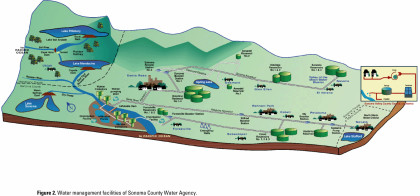Update: Sonoma Valley groundwater supply
 (By Fred Allebach) — The Sonoma Valley groundwater budget is in the red and one plan for future groundwater sustainability is to recharge Sonoma Valley aquifers with winter Russian River drinking water.
(By Fred Allebach) — The Sonoma Valley groundwater budget is in the red and one plan for future groundwater sustainability is to recharge Sonoma Valley aquifers with winter Russian River drinking water.
The Sonoma County Water Agency (SCWA) has received a grant to drill monitoring wells intended to assess the feasibility and potential effects of such groundwater recharge. The grant allows funds the drilling of two shallow monitoring wells to scope locations that may be conducive to surface-water-based, stormwater recharge techniques. These two wells are yet to be drilled and are initially planned to be sited along Carriger Creek on Fowler Creek Road and along Sonoma Creek in Kenwood.
One of the monitoring wells completed in the El Verano area showed groundwater with elevated temperatures and chemical composition indicative of geothermal activity at a depth of approximately 600 feet. The presence of geothermal indicators means the well is likely near a fault zone. The North Bay is on top of a “hotspot” of geothermal activity that appears to be moving along with the blocks of land associated with the San Andreas Fault.
Should groundwater from this well location be used for potable water, the water would need to be treated before achieving drinking-water quality. The addition of recharged Russian River drinking water to this groundwater could dilute the geothermal-related chemicals and make treatment less costly or unnecessary. Tests will be done to assess the compatibility of Russian River and local groundwater.
One possible plan is to use the well #6 in the City of Sonoma, adjacent to the Veterans Building parking lot and the Overlook Trail kiosk, to test and monitor water recharge into the newly drilled test well.
In other groundwater news, the USGS is studying Sonoma Valley’s groundwater quality, including electrical conductivity in groundwater. Electrical conductivity shows the presence of minerals and ions in the water, in particular, salinity. Preliminary results show a higher percent of salinity in the southeast and southern sections of the Valley. This higher conductivity is likely from contact with chemical precipitates from both contact with volcanic rock, ancient deep sedimentary formations and geothermal effects.
When groundwater declines from over-pumping, it has been assumed that brackish, salty water from San Pablo Bay would move in to replace the lost volume. Higher salinity has been noted in deep southern and southeastern Valley aquifers before. But in the preliminary USGS report, higher salinity intrusions in the above-mentioned areas do not appear to be related to current sea water chemical signatures. Interestingly, the saline conductivity appears to be from older (connate) salt water entrapped in the pores of sediments as they were deposited.
Groundwater from valley deep aquifers can be dated by various means, and connate salty water could be over 10,000 years old. During the Pleistocene ice age, (the last 2.5 million years minus 18,000 years) sea levels were at times higher than they are today.
A picture is emerging that even if modern San Pablo Bay salty water is not intruding aquifer voids left from groundwater over-pumping, lower quality waters from other sources, including geothermally-mixed waters, may be degrading the drinking water quality of such aquifers.



